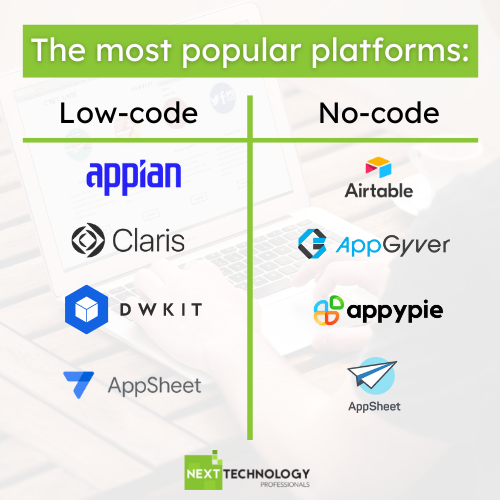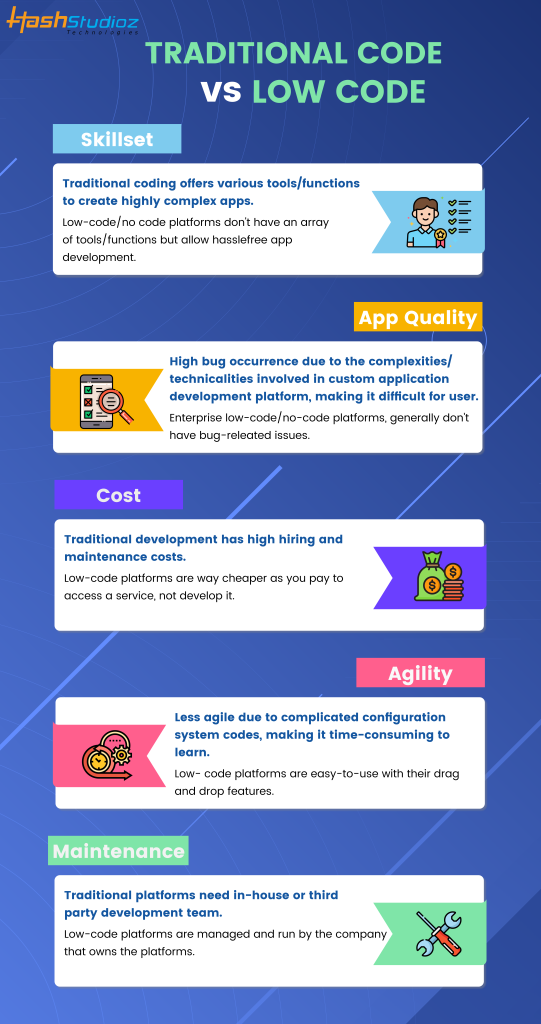New Ideas On Deciding On Low-Code Platform Info
New Ideas On Deciding On Low-Code Platform Info
Blog Article
Benefits Of Low-Code Application Development With Regard To Accessibility For Non-Developers
App development that is low-code improves accessibility for non-developers (often called "citizen-developers") due to several key elements.
Drag-and-Drop Builders : Low-code platforms offer drag-and–drop interfaces which enable people who are not developers, and without the need to write code, to develop visual applications. This makes the development process easier for those with no technical backgrounds.
WYSIWYG: WYSIWYG editors are "What you see is what you Get" editors that allow users to design workflows and interfaces similar to the finished product. It makes it much simpler to use and understand.
Simplified Design of Workflow Logic and Workflow:
Visual Workflow Modelling: Users can use visual workflow to create business processes, applications logic and flowcharts using models as well as visual flowcharts. These methods are much more intuitive than the conventional coding techniques.
Low-code platforms typically include pre-built logic components (e.g. conditionsal statements loops, conditional statements) which can be easily set up, reducing the need for complex coding.
Reusable components and templates:
Libraries of Templates that are pre-built Many platforms that offer low-code have templates available that are suitable for most applications. This lets developers start quickly and efficiently, while non-developers can customize the templates as they see the need.
Reusable Widgets and Modules: Users can use reused widgets. This simplifies the creation and reduces the need of in-depth understanding.
Guided Development and Tutorials
Step-by-Step Guides: Platforms usually provide guided development paths as well as tutorials and on-screen guidelines to assist novice developers in building applications.
Interactive Tutorials Interactive tutorials are interactive and hands-on that allow users to learn through doing. This boosts the confidence of users in the platform.
Integration of existing tools:
Easy Integration: Low-code platforms are built to easily integrate with existing business tools and systems (e.g. CRM, ERP and ERP) and allow non-programmers to build applications that fit with their existing workflows.
APIs connectors and APIs: These devices simplify integration by allowing non-developers (or even users) to link their applications with external services.
Collaboration Features:
Team Collaboration Features, such as real-time collaboration and shared workspaces, allow non-developers and professionals to work together effectively.
Role-Based Access Control: Non-developers can be assigned specific roles that have appropriate access levels, which ensures they are able to contribute to the process of development without having to compromise security and functionality.
Automated Testing and Debugging:
Low-code platform often comes with an integrated testing and debugging tools that automates this process. Non-developers are now able to verify that their app is working correctly.
Platform identifies errors as they happen and suggests solutions. This helps non-developers with problems.
The capacity of low-code software to allow development to non-developers is their biggest advantage. By offering an intuitive, visually-guided tool and experiences, low-code platforms enable business owners to actively participate and maintain applications. Check out the top rated Low-code Platform for application development for website advice including cross platform app development, rapid applications, cross platform mobile dev, jdbc server, mobile development platforms, low code platforms, cross platform mobile app development, develop cross platform mobile app, app modernization, build with docker and more.
The Cost-Effectiveness Of Low-Code Development Is Among The Major Benefits.
Low-code apps offer many benefits, including cost efficiency. This is a great option for businesses who want to reduce development costs without sacrificing quality. The main benefits are reduced development costs:
Less Coding Requirements: The low codes platforms remove the need for extensive hand-coded, custom-built applications. Developers can spend less time and effort building apps. It also means lower costs for labor.
Lower Developer Resources: As low-code is more efficient and less time to create, less skilled developers will be required. This will reduce the cost of hiring and staffing.
Speedier Time to Market
Accelerated Cycle of Development: Low-code platform visual tools and components facilitate rapid development of applications. This allows businesses to launch products faster. This could lead to quicker revenue growth and improved position in the marketplace.
Rapid prototyping allows businesses to build prototypes and test them in a short time, which reduces the amount of time needed for the development phase. This lets them make quicker iterations after receiving user feedback.
Lower cost of maintenance:
Simpler Maintenance: Low-code platforms with their standardised components and modular architecture, are easier to maintain. This reduces the cost of ongoing maintenance and support.
Automated Updates. Many low-code platforms manage patches and updates automatically. Applications remain secure without requiring a lot of manual input.
Efficient Resource Utilization:
Contributions by non-developers Low-code platforms enable non-developers and business users to take part in the process of development. This makes it possible for businesses to take advantage of the skillsets of a wide spectrum of employees.
Optimized Use Of IT Resources: IT teams can concentrate on strategic projects instead of being stymied by routine development work, improving efficiency and productivity overall.
Price models that can be scaled:
Subscription Pricing: Many platforms with low-code support flexible pricing models based on subscriptions that can be scaled depending on usage. This allows businesses to alter their budgets to meet their requirements and needs without the need to incur large upfront costs.
Pay-as-you-go Options Certain platforms offer pay-as-you-go options that ensure that businesses only pay for the resources they utilize and can be especially beneficial for startups and small companies with a limited budget.
Lowering Third-Party Costs of Software:
Low-code platforms have built-in integrations and functionalities, which could reduce the cost of software subscriptions and licensing.
Pre-Built Integrations: Availability of pre-built integrations with popular services and systems minimizes the requirement for custom development, which saves both time and money.
Better ROI
A faster return on investment (ROI): By the combination of rapid development, reduced costs and a shorter time to market, companies can get a faster ROI for their applications.
Increased Agility: Businesses are able to quickly adapt to changes in the market and the needs of customers and ensure that they remain current and take advantage of new opportunities as they arise.
Lower Cost of Training
Low-Code Platforms have User-Friendly Interfaces. The simple and user-friendly interfaces help ease the learning curve of new users. This eliminates the need for intensive training programs.
Accessible resources: Many low-code platforms have comprehensive tutorials, training materials, and community assistance and help, which can reduce the need for formal education.
Collaboration can be made more efficient.
Enhanced collaboration Tools: The integration of collaboration tools allows for improved communication between team members as well as a reduction in project overhead.
Unified Development Environment : A unified environment makes work easier and lowers the cost of managing multiple tools and platforms.
Overall, the efficiency of software development using low-code can be attributed to its capability to lower the cost of maintenance and development as well as increase the time to market, optimize resource use, and also provide flexible pricing models. Low-code offers substantial financial advantages for companies. Take a look at the top rated sell on Enterprise application development with Low-code Platform for site advice including developing mobile apps, app platforms, no code platforms, application modernisation, app development platform, app dev platform, rapid application design, develop web app, application development platforms, rapid app development and more.
Benefits Of Low-Code App Development In Terms Limitations And Customization
Low-code app development is a balancing solution that offers significant benefits in addressing limitations while permitting customization. The main advantages are: limitations:
Removing Complexity Barriers
Low-code platforms simplify development by providing templates that are pre-built and components. This allows for rapid deployment and the development of more complex applications.
Guided Workflows: Many platforms have guided workflows as well as wizards to assist developers in navigating through complex processes, reducing the risk of mistakes and ensuring consistency.
Scalability Solutions
Scalability is built into: Low-code platforms often include features that enable an architecture that is scalable. Applications are able to handle higher workloads with minimal redevelopment.
Performance Monitoring: Tools that monitor and optimize performance assist to make sure that applications run efficiently, even when they grow.
Security and Compliance
Integrated Security Features: Low code platforms are equipped with security measures built in, such as encryption and access control based on role. They also conduct automated checks for compliance to identify security issues.
Platforms frequently update their security and compliance measures to ensure that applications are protected against new threats.
Customization capabilities:
Extensibility:
Low-code platforms permit developers to extend functionality beyond standard offerings by adding customized code.
Developers are able to add customized modules or plugins to meet specific business needs.
APIs & Integration:
API Support: Full API support is available to enable seamless integration and connection to external systems.
Low-Code Platforms: These platforms offer built-in connectors for well-known third-party service providers. This makes it easier to add and modify apps.
Flexible Design of UI/UX:
Customizable Interfaces Developers are able to create and alter user interfaces in line with specific branding and usability requirements which results in a custom user experience.
Responsive Designs: The software can be customized to suit various screen sizes and devices.
Business Logic Customization
Visual Workflow Builds Visual tools that permit the modification of workflows as well as business rules and to design complex, tailored processes.
Platforms offer conditional logic to meet certain business rules or situations.
Data Management
Custom Data Models Developers have the ability to build custom data models tailored to specific business needs. This means that the handling of data is customized for each application.
Advanced Data processing Integration advanced tools for data handling allow for the customisation of data analysis and usage within the application.
Balance Customization and Limitations:
Frameworks and Standards
Best Practices for Compliance Low-code platforms facilitate adhering to industry best practices and standards. This assists in maintaining high-quality robust, and secure applications.
Governance Frameworks - Built-in governance frameworks make sure that any modifications do not affect security, integrity, or compliance.
Iterative Development and Feedback
Rapid prototyping: Being capable of rapidly prototyping and test customizations, developers are able to iterate on user feedback to improve the functionality of the application.
Continuous Improvement: Low code platforms permit constant improvements. They are able to be modified and customized when business requirements change.
Empowering Users:
Giving Citizen Developers the ability to be empowered In giving non-developers the opportunity to customize their applications through intuitive interfaces and low-code platforms they increase the number contributors who are able to enhance and tailor application.
Training and support: Many platforms include extensive training resources and support services to assist users in creating customizations that work without compromising the application's performance or stability.
In general, low-code application development provides a robust framework that can address the limitations and provide ample customization opportunities. This allows businesses to develop and maintain applications that function, are tailored to their particular requirements and meet the highest standards in terms of security, quality, and scalability.